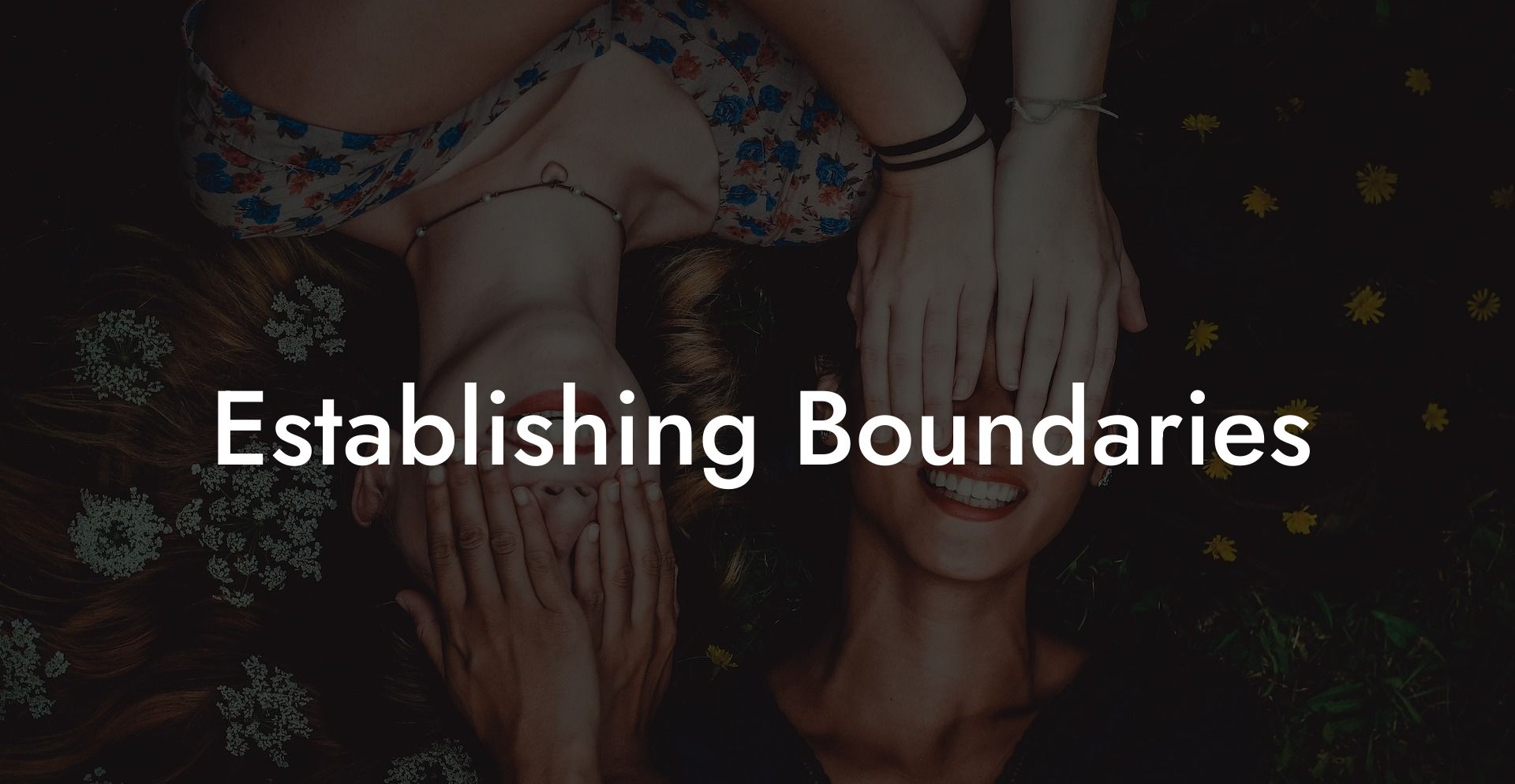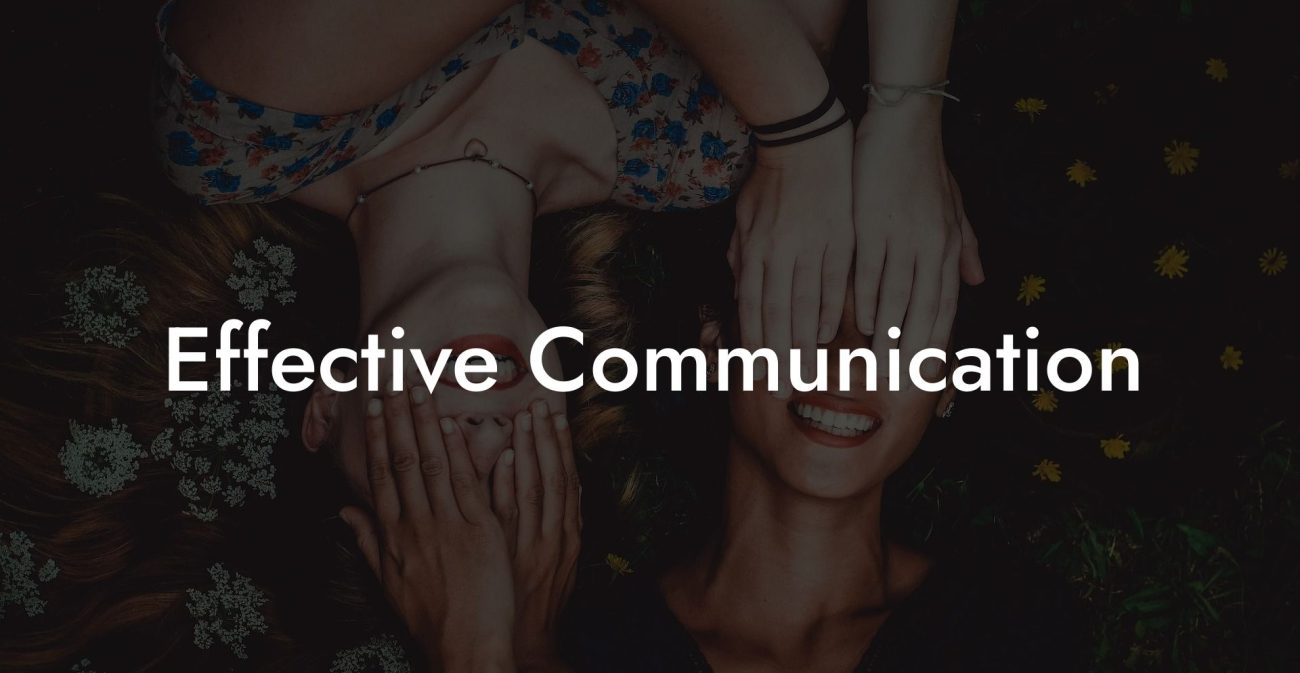Establishing Boundaries

Imagine if setting boundaries was as empowering as drawing the perfect line in a masterpiece, one that protects your personal space while still inviting others in for a vibrant splash of color. In the dynamic world of relationships, whether traditional monogamy or ethical non-monogamy, establishing clear boundaries is the secret sauce to maintaining balance, trust, and genuine connection. This comprehensive guide explores how to set, negotiate, and maintain boundaries in both conventional and non-traditional relationship dynamics, offering practical strategies, real-life examples, and expert insights to help you navigate your love life with confidence and clarity.
Quick Links to Useful Sections
- What Are Boundaries in Relationships?
- Defining Boundaries
- Why Boundaries Are Crucial in Relationship Dynamics
- Protection and Self-Care
- Building Trust and Mutual Respect
- Preventing Misunderstandings and Conflict
- Types of Boundaries in Traditional and Non-Traditional Relationships
- Emotional Boundaries
- Physical Boundaries
- Time Boundaries
- Communication Boundaries
- Financial and Logistical Boundaries
- Establishing Boundaries in Traditional Monogamy vs. ethical non-monogamy
- Traditional Monogamy
- Ethical Non-Monogamy
- Strategies for Establishing and Maintaining Boundaries
- Start with Self-Reflection
- Engage in Open Dialogue
- Document Your Agreements
- Establish Regular Review Sessions
- Leverage Digital Tools
- Seek External Support
- Real-Life Examples and Success Stories
- Case Study: Emma and Liam’s Monogamous Balance
- Case Study: Jordan, Casey, and Alex in Ethical Non-Monogamy
- Expert Insights on Boundary-Setting
- FAQ: Your Establishing Boundaries Questions Answered
What Are Boundaries in Relationships?
Defining Boundaries
Boundaries are the explicit or implicit limits we establish to protect our physical, emotional, and mental well-being. They serve as guidelines for acceptable behavior and interactions within a relationship, ensuring that both partners feel respected and secure. Boundaries can be as simple as deciding on personal time or as complex as negotiating emotional needs in a multi-partner setup.
In essence, boundaries help define who you are, what you need, and how you expect to be treated, whether you’re in a traditional monogamous relationship or exploring the expansive possibilities of ethical non-monogamy.
Why Boundaries Are Crucial in Relationship Dynamics
Protection and Self-Care
Boundaries act as a form of self-care. They protect your emotional and physical energy from being depleted, ensuring you have the space to grow and thrive. When you set clear limits, you create a safe space where you can be authentic without fear of being overwhelmed.
In any relationship, knowing and respecting your own limits, as well as those of your partner(s), is essential. It allows you to maintain your identity, foster self-respect, and avoid burnout, even in the most intense romantic connections.
Building Trust and Mutual Respect
Trust is built when both parties understand and honor each other’s boundaries. When you consistently respect the limits that you and your partner(s) have set, it creates a strong foundation of mutual respect and security. Whether it’s the exclusive emotional space in monogamy or the negotiated limits in non-monogamous arrangements, clear boundaries pave the way for deeper trust.
Preventing Misunderstandings and Conflict
Misunderstandings often arise when expectations are vague or unspoken. Boundaries ensure that both partners have a clear understanding of what is acceptable and what is not. This clarity reduces the risk of conflict and helps prevent hurt feelings by aligning expectations from the outset.
Types of Boundaries in Traditional and Non-Traditional Relationships
Emotional Boundaries
Emotional boundaries involve defining the level of emotional intimacy you’re comfortable sharing. In traditional monogamy, this might mean dedicating certain moments exclusively to one another, such as deep, heart-to-heart conversations. In ethical non-monogamy, it could involve distinguishing between the emotional support you expect from a primary partner versus that from secondary connections.
- Example: “I need quiet, uninterrupted time in the evenings to process my day, so let’s agree that our deep conversations happen during our weekly date night.”
Physical Boundaries
Physical boundaries dictate what forms of touch and intimacy are comfortable for you. They might include agreements on sexual activities, public displays of affection, or even personal space.
- Example: “I’m comfortable with holding hands and casual kisses in public, but I prefer more intimate activities to remain private between us.”
Time Boundaries
Time boundaries are essential, especially in relationships where multiple connections exist. They help you allocate quality time for each relationship and ensure that you’re not spreading yourself too thin.
- Example: “Let’s schedule one-on-one date nights on Tuesdays and Thursdays, and set aside Sundays for group activities or personal time.”
Communication Boundaries
Communication boundaries define how much and what type of information you share with your partner(s). They set expectations for the frequency, tone, and depth of your interactions.
- Example: “I prefer to keep details about my one-on-one dates private, but let’s discuss any significant changes during our monthly relationship check-ins.”
Financial and Logistical Boundaries
In relationships that involve shared responsibilities, financial and logistical boundaries help clarify how resources and duties are managed. This is particularly important in long-term partnerships and non-traditional family structures.
- Example: “We’ll split household expenses equally and maintain separate savings accounts for personal use, but we’ll have a joint account for shared goals like vacations and bills.”
Establishing Boundaries in Traditional Monogamy vs. ethical non-monogamy
Traditional Monogamy
In traditional monogamous relationships, the focus is on two people supporting and committing exclusively to each other. Boundaries here tend to be simpler, as they revolve around shared expectations and mutual exclusivity. Common practices include daily check-ins, designated date nights, and discussions about personal space and individual growth.
The simplicity of having one partner can make it easier to establish and maintain boundaries because there are fewer variables and less complexity. However, it’s still crucial to communicate openly and adapt boundaries as life evolves.
Ethical Non-Monogamy
Ethical non-monogamy introduces additional layers of complexity due to the presence of multiple partners. In these dynamics, boundaries must be negotiated both collectively and individually. This often involves setting up different rules for various relationships, whether you designate some as primary and others as secondary or allow all connections to exist on an equal footing.
For example, you might have group meetings to discuss overall relationship health while also maintaining individual check-ins with each partner. The key is to ensure that all parties feel respected and that the boundaries are flexible enough to adapt as relationships evolve.
Strategies for Establishing and Maintaining Boundaries
Start with Self-Reflection
Before you can set effective boundaries with others, you must understand your own needs, values, and limits. Take time to reflect through journaling, meditation, or therapy. Ask yourself:
- What makes me feel safe and respected?
- Where do I need personal space?
- What types of intimacy are most important to me?
- How do I prefer to manage my time and emotional energy?
This self-knowledge forms the foundation for establishing clear and authentic boundaries.
Engage in Open Dialogue
Communication is key to boundary-setting. Initiate conversations with your partner(s) about what you need and listen actively to their perspectives. Use “I” statements to express your feelings without assigning blame. For instance, “I feel overwhelmed when I don’t have time to recharge” is more constructive than “You always drain my energy.”
Create a safe space for these discussions by setting ground rules for respect and empathy, ensuring that everyone feels heard.
Document Your Agreements
Consider creating a written or digital document that outlines your agreed-upon boundaries. This “relationship contract” doesn’t have to be legally binding, it simply serves as a reference to help everyone remember and honor the commitments made.
Tools like Google Docs, Notion, or even a shared journal can be invaluable in keeping these agreements accessible and up-to-date.
Establish Regular Review Sessions
Boundaries are not set in stone; they evolve as your needs and circumstances change. Schedule regular check-ins, whether monthly or quarterly, to revisit and adjust your boundaries. This proactive approach ensures that everyone remains comfortable and that any issues are addressed promptly.
Leverage Digital Tools
In today’s busy world, digital tools can help keep your boundary agreements organized and accessible. Use shared calendars to coordinate quality time, messaging apps for regular communication, and digital journals to track your reflections and progress. These tools help ensure that boundaries are not only set but also consistently maintained.
Seek External Support
Sometimes, navigating complex boundaries can be challenging, especially in non-traditional relationships. Consider seeking guidance from a therapist or relationship coach experienced in diverse relationship models. Engaging in workshops, support groups, or online communities can also provide fresh perspectives and practical advice.
Real-Life Examples and Success Stories
Case Study: Emma and Liam’s Monogamous Balance
Emma and Liam have been together exclusively for over a decade, and their secret to success lies in their commitment to regular check-ins and clearly defined personal space. They established daily debrief sessions and weekly date nights that focus solely on deep, uninterrupted conversation. Over time, these practices have fostered a profound sense of trust and emotional intimacy. Their example shows that even in traditional monogamy, boundary-setting is vital for maintaining a harmonious and resilient relationship.
Case Study: Jordan, Casey, and Alex in Ethical Non-Monogamy
In a triad where transparency is key, Jordan, Casey, and Alex faced challenges in coordinating their time and managing emotional boundaries. By implementing group meetings alongside one-on-one check-ins and using a shared digital calendar, they successfully navigated the complexities of non-monogamy. Each partner has clear guidelines for communication and personal time, which has led to a more balanced and fulfilling network of relationships.
Expert Insights on Boundary-Setting
Relationship experts consistently emphasize that boundaries are the foundation of healthy relationships. Dr. Elena Rivera, a therapist specializing in diverse relationship dynamics, explains, “Boundaries are not walls; they are bridges that enable each person to feel safe and respected. When set with care and communicated openly, they allow for the freedom to love fully without fear of emotional overwhelm.”
Relationship coach Marcus Lee adds, “Effective boundary-setting is an ongoing process that requires self-awareness, honest dialogue, and the willingness to adapt. Whether you’re in a monogamous or non-monogamous relationship, clear boundaries are essential for maintaining mutual respect and emotional well-being.”
FAQ: Your Establishing Boundaries Questions Answered
1. What are boundaries in relationships?
Boundaries are the guidelines and limits that individuals set to protect their physical, emotional, and mental well-being in a relationship.
2. Why are boundaries important?
They help prevent misunderstandings, reduce jealousy, and ensure that each partner’s needs and limits are respected, fostering a safe and supportive environment.
3. How do I start setting boundaries?
Begin with self-reflection to understand your own needs, then engage in open dialogue with your partner(s) using “I” statements, and consider documenting your agreements for clarity.
4. Can boundaries change over time?
Yes, boundaries should be regularly reviewed and adjusted as your relationship and personal needs evolve.
5. What are examples of emotional boundaries?
Examples include designating exclusive emotional check-in times with a primary partner or deciding how much personal detail is shared among different partners.
6. What are examples of physical boundaries?
Physical boundaries might include agreements on safe sex practices, acceptable public displays of affection, or defining what types of physical intimacy are reserved for private time.
7. How can I manage time boundaries?
Use digital tools like shared calendars and scheduling apps to allocate quality time for each relationship and ensure a balanced schedule.
8. How do I handle communication boundaries?
Set clear guidelines on how frequently you communicate and what information is shared about other relationships, and establish regular check-ins to ensure everyone is on the same page.
9. What if a partner doesn’t respect the boundaries?
Address breaches immediately through open, honest conversation, and consider seeking professional support if the issue persists.
10. Where can I find more resources on boundary-setting?
Books like "The Ethical Slut" and "More Than Two", podcasts such as “Multiamory,” and online communities on Reddit and Facebook offer extensive insights and advice on establishing healthy boundaries.
Resources and Community Support: Your Next Steps in Mastering Boundaries
- "The Ethical Slut" by Dossie Easton & Janet Hardy – A foundational text offering practical advice on navigating non-traditional relationships and setting healthy boundaries.
- "More Than Two" by Franklin Veaux & Eve Rickert – Provides in-depth insights and real-life examples of effective boundary-setting in polyamorous contexts.
- Podcasts: Listen to "Multiamory" and similar shows for expert advice and personal stories on managing relationship boundaries.
- Online Communities: Engage with forums on Reddit (e.g., r/polyamory) and Facebook groups dedicated to polyamory for shared experiences and tips.
- Workshops and Webinars: Attend events that focus on communication, self-care, and boundary-setting to further develop your skills.
- Therapy and Counseling: Seek professional support from therapists or coaches experienced in polyamorous relationships for personalized guidance.
Mastering boundaries is an ongoing journey that empowers you to create relationships where each connection can flourish. With thoughtful self-reflection, clear communication, and a supportive community, you can establish boundaries that not only protect your well-being but also enrich your relationships in every way.
Lost & confused by all of the terms, types and seemingly made up 3 letter acronyms?? We've got you. Check out our Ethnical Non-Monogamy Dictionary >>
Useful Interruption: Not sure which relationship vibe fits you best? Take our Relationship Test, it’ll give you the real insight into your natural relationship style. Then, dive into our binge-worthy guides (from the tried-and-true to the “wait, that’s a thing?”) and find the perfect relationship type for your life:
- Monogamy
- Open Relationships
- Ethical Non-Monogamy
- Solo Polyamory
- Non-Hierarchical Polyamory
- Hierarchical Polyamory
- Relationship Anarchy
- Swinging
Now back to the main article but yeah take the test...



